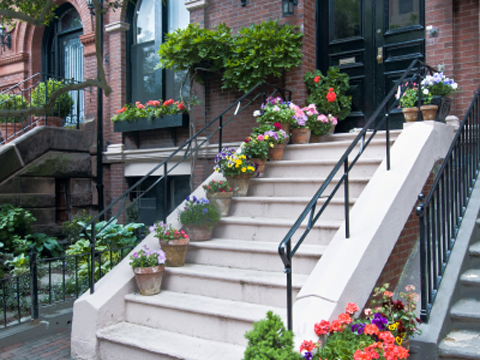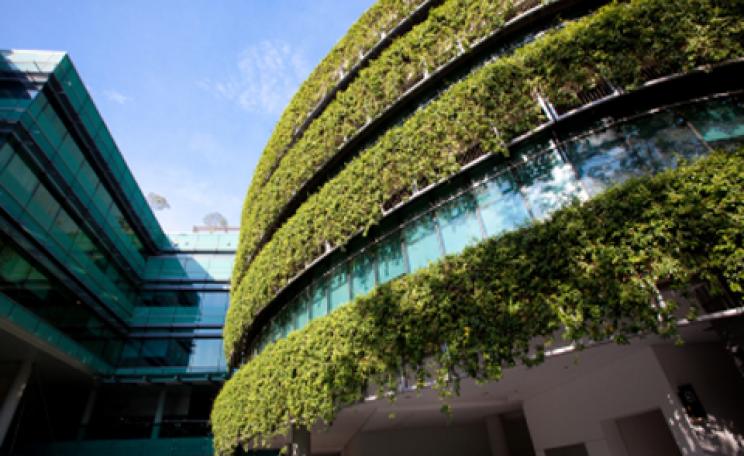Each year, the Chelsea Flower Show attracts more than 157,000 visitors over five days, drawn by the prospect of wonderful design and colourful blooms. But it’s not all about competitive garden design: this year’s show will also have much for environmentalists. RHS Environment is a new initiative that focuses on showing the rest of us how to maximise the planet friendliness of our green spaces – however small. ‘Lots of vegetables, such as courgettes, grow well in containers,’ explains Dr Rebecca Slack from the University of Leeds, one of the exhibitors in the RHS Environment section. ‘Buying peat-free compost is something everyone can do, irrespective of the size of their outdoor space.’
Leeds will be displaying a bee-friendly garden (pictured below left) with the aim of introducing the concept of urban ecosystem services to the gardener. ‘Urban ecosystems such as gardens, parks, roundabouts and so on can offer lots of benefits or services to gardeners and users of green spaces,’ adds Slack. ‘While these services can include boosting health and wellbeing or improving air quality, we’re focusing on three services: pollination, water management and carbon storage.’ Three themes that the university believe are important factors that affect the lives of everyday people. ‘We often think of the environment as tropical rainforest half way around the world that we can’t do anything about,’ says Leigh Hunt, principal horticultural advisor at the RHS, ‘but as we’re finding now, whether it’s biodiversity or environmental benefits, they really are on our doorstep.’
Along with Leeds, other exhibitors will include the University of Reading, the Food and Environment Research Agency (FERA), Groundwork UK and Architecture Sans Frontières. Among the themes are community, water management and harnessing the power of plants to help reduce energy usage and heating costs. ‘What we are trying to achieve with this is to raise awareness of the fact that it’s the variety in planting that helps the urban greening achieve more than one benefit in the urban environment,’ says Tijana Blanusa from the University of Reading.  ‘Singularly there are various plants that do different things but it’s how you combine them that potentially has the biggest [positive] impact on the environment.’
‘Singularly there are various plants that do different things but it’s how you combine them that potentially has the biggest [positive] impact on the environment.’
Gold award winner last year with its ‘Cocoa garden', Reading is presenting an urban space called Keeping their Cool: how the plants in the urban environment can help reduce temperatures, control flooding and capture pollution. Their garden will contain a scientist carrying out experiments and visitors will be able to see how common garden plants function biologically; the rate at which they lose water and the way they are structured. ‘It’s about how understanding them can help us to combine them in a way to get the most out of them,’ explains Blanusa ’It’s not only in terms of cooling but also how they capture rain or particular pollutants in the atmosphere.’
Of course, with the British climate full of peaks and troughs, knowing how to protect our gardens, particularly during a drought is important. RHS Environment aims to teach gardeners the plants that can stand long dry periods and those that cannot, as well as ways to make the most of native species. ‘The conservation approach is always good in terms of environmental practice because the idea is that you need a makeover isn’t very sustainable and again it has that carbon footprint attached to it,’ comments Hunt. ‘So it’s really about adapting and thinking ‘yeah I’ve got a great shrub there, I’ve got a tree thankfully, so what more can I squeeze in that will make a difference?’ ‘Our gardens tend to be filled with plants that cannot tolerate extended dry periods,’ explains Harward. ‘Traditional planting can still be used if the garden is managed for water retention during heavy rainfall.’ Building a rain garden that retains most of the rainfall within a garden will help during a drought as will installing permeable pathways to ensure that any water does not drain off the garden but will seep into the soil.  Other eco-friendly garden ideas include adding green roofs to your buildings to make your garden drought efficient and limit the speed at which water flows from a garden. Knowing the different plants that can retain water is another factor to consider or whether lighter or darker colours on a plant can have an effect. ‘Lighter colours are potentially interesting when stressed because those plants do retain lower leaf temperatures,’ explains Blanusa. ‘So perhaps they could offer better cooling even when the water is limited.’ Hairy complex leaves, which are not shiny or waxy, found on shrubs such as salvias and conifers are good because they trap more pollutants and can hold onto more water than their smoother cousins.
Other eco-friendly garden ideas include adding green roofs to your buildings to make your garden drought efficient and limit the speed at which water flows from a garden. Knowing the different plants that can retain water is another factor to consider or whether lighter or darker colours on a plant can have an effect. ‘Lighter colours are potentially interesting when stressed because those plants do retain lower leaf temperatures,’ explains Blanusa. ‘So perhaps they could offer better cooling even when the water is limited.’ Hairy complex leaves, which are not shiny or waxy, found on shrubs such as salvias and conifers are good because they trap more pollutants and can hold onto more water than their smoother cousins.
‘Little changes amount to great things and if we all did something, this would really amount to some big national changes,’ says Slack. As the Chelsea gardens hope to prove, when done right, gardens can provide a real boost to biodiversity and help tackle pollution and climate change at the same time. ‘Our garden actively demonstrates how with clever, minimal changes to their gardens, everyone can be an ecosystem services champion,’ continues Slack. Forget Diarmuid Gavin’s pyramid garden - that’s something we can all aspire to.
For more information on RHS Environment and tickets, see www.rhs.org.uk
| READ MORE... | |
 |
GREEN LIVING How to handle the hosepipe ban: everything you ever wanted to know Despite the spring downpours, a hosepipe ban is already in force thanks to drought. It’s time to rethink how we use water in the garden, says author Michael Littlewood |
 |
GREEN LIVING Top 10... organic seed suppliers As the weather heats up, gardeners’ thoughts are turning towards seeds. We round up the top spots to pick up organic, ethically produced seeds |
 |
GREEN LIVING Why bees & biodiversity benefit from indigenous wildflowers Filling your garden with wildflowers helps honeybees and butterflies, and creates a relaxed mood. And, from the Easton Walled Garden to Sissinghurst, there's plenty of inspiration |
 |
GREEN LIVING Ten of the best…ways to get stuck into urban gardening Growing your own fruit and vegetables doesn’t have to involve huge amounts of space. As Hannah Corr explains, there are plenty of short cuts for city dwellers who want to get stuck in |
 |
GREEN LIVING The beginner’s guide to making your own compost Contrary to popular belief, composting is simple. What’s more, it’s also eco-friendly, cheap and utterly addictive. Hannah Corr shows you how to get started |








